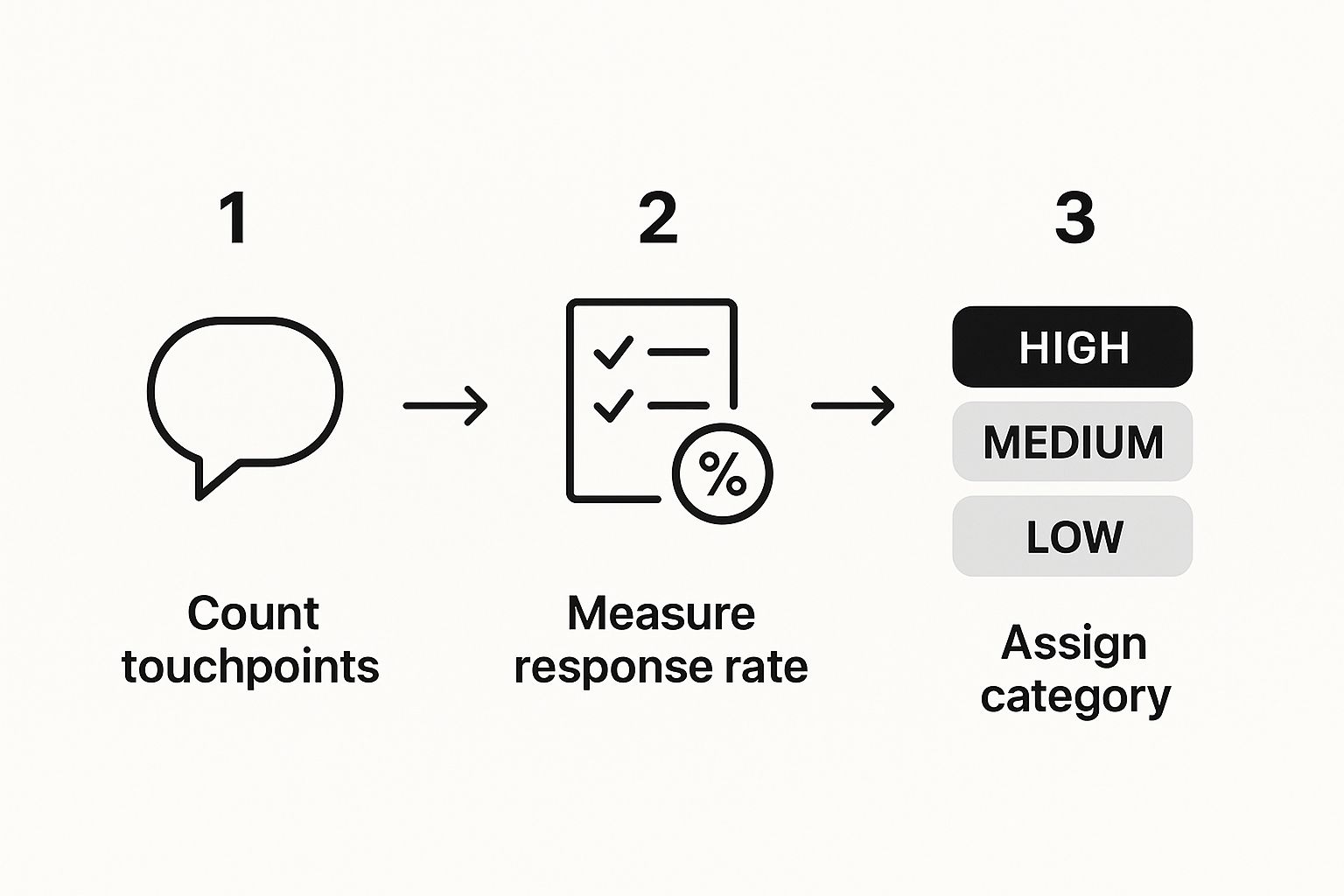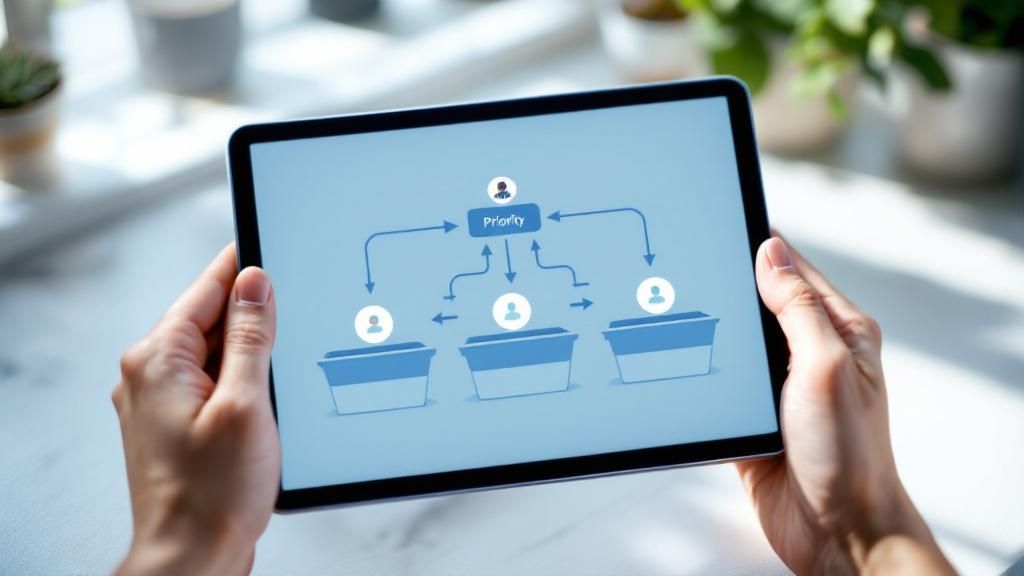When it comes to sales, you have to prioritize. It's the only way to sift through the noise and zero in on prospects who are actually likely to become customers. This isn't just about being organized; it's about systematically evaluating, scoring, and ranking every opportunity so your team can focus their energy where it counts. Get this right, and you'll see a massive jump in both efficiency and conversion rates.
Why Prioritizing Leads Is Your Biggest Growth Lever

Let's be real for a second. Not all leads are created equal. You can have a flood of new prospects pouring in, which feels great on the surface. But if your sales team is spinning its wheels chasing people who will never buy, you're just burning cash and morale.
It’s a classic B2B problem: lead volume is high, but you keep missing your revenue targets. The culprit is almost always a lack of a smart system for sorting the gold from the gravel.
The Hidden Costs of Poor Prioritization
Without a clear method for ranking your leads, you're bleeding resources in ways that go far beyond just missed sales. These issues pile up, actively holding back your growth.
- Wasted Marketing Spend: Your marketing team is working its tail off to generate interest. When sales reps can't tell a hot lead from a cold one, those precious marketing dollars are flushed down the drain on dead-end conversations.
- Sales Team Burnout: Nothing kills a salesperson's spirit faster than a pipeline filled with duds. Facing constant rejection and putting in fruitless effort leads directly to high turnover and a stressed-out, underperforming team.
- Lost Opportunities: This one hurts the most. While your team is busy with low-potential leads, your competitors are swooping in and talking to the high-value prospects who are actually ready to make a decision. Every minute spent on the wrong lead is a genuine opportunity lost.
The hard truth is that a huge chunk of new leads will never convert. If you don't prioritize, you aren't just being inefficient—you are actively letting future revenue walk out the door.
From Chaos to Clarity
The average business pulls in over 1,800 leads a month, with each one costing nearly $200 to get. Even more telling? A staggering 44% of sales reps say they're too busy to follow up properly. These numbers paint a clear picture of just how urgent the need for a solid system is.
When you finally implement a real strategy for prioritizing sales leads, you transform your entire process. You shift from a reactive scramble to a proactive, data-driven operation. This is where automation really shines, unlocking the full potential of lead prioritization by boosting efficiency and cutting costs. You can learn more about the critical business process automation benefits that underpin a strong framework.
Ultimately, this shift makes lead prioritization more than just an efficiency hack. It becomes your most critical lever for sustainable growth.
Building Your Ideal Customer Profile

Before you even think about scoring or ranking leads, you need to know exactly who you're looking for. Without this, you're just casting a wide net and hoping for the best—a surefire way to waste time and resources.
This is where your Ideal Customer Profile (ICP) comes in. It's the blueprint of your perfect customer, built on real data, not guesswork. Think of your ICP as your sales team's North Star. It guides every decision you make, from lead generation to prioritization. It's so much more than a list of company sizes and industries. A truly effective ICP layers different kinds of data to paint a vivid picture of the companies that will get the most value from your product and stick with you for the long haul.
Once you have this profile locked down, the initial sorting of leads becomes incredibly simple. A new lead comes in, you hold it up against your ICP, and you get an instant gut check. Is it a match? Great, it’s a high-potential lead. No? It goes into a lower-priority bucket. This is the first, most crucial step in prioritizing your sales pipeline.
Go Beyond Basic Firmographics
A lot of teams make the mistake of stopping at surface-level details. Sure, you need the basics, but that’s just the starting line. A powerful profile digs much deeper.
-
Firmographics: This is your foundation. We're talking company size, industry, revenue, and where they're located. It tells you what the company is.
-
Technographics: This is where it gets interesting. What tech stack are they using? If you know they use a tool that integrates perfectly with yours (or even a competitor's product you can replace), that's a massive buying signal.
-
Behavioral Data: This is all about their actions. Have they been clicking around your pricing page? Did they download that new whitepaper? This kind of data shows they're not just a good fit on paper—they're actively interested right now.
If you need a hand filling your pipeline with these kinds of prospects, check out our guide on B2B sales lead generation. It's packed with actionable strategies.
A Practical SaaS Example
Let's make this real. Imagine you sell project management software that has killer integrations with HubSpot and Slack.
A weak, fuzzy ICP might be: "Tech companies with 50-200 employees." That’s way too broad and will leave your sales reps chasing ghosts.
Now, here’s what a strong, multi-layered ICP looks like:
A B2B tech company with 50-200 employees in North America. They must be actively using HubSpot for CRM and Slack for team chat. Bonus points if they've recently visited our integrations page or downloaded our productivity case study.
See the difference? It’s night and day.
With this level of clarity, you're no longer just guessing. You can look at any lead and know, with a high degree of confidence, if they're worth a salesperson's valuable time. This profile becomes the very foundation of your lead scoring system, ensuring your team only focuses on the deals most likely to close.
Designing a Predictive Lead Scoring System
Okay, so you've nailed down your Ideal Customer Profile (ICP). Now for the fun part: turning that theory into a system that actually works for you. This is where we build an actionable scoring system, translating who your best customers are into a simple numerical framework. The goal? To automatically bubble your hottest opportunities right to the top. It’s all about assigning points based on real buying signals.
A solid lead scoring model hinges on two distinct types of information:
- Explicit Data: This is the stuff you can see, the hard facts about a lead. Think job title, company size, industry, or even where they're located. This data tells you how well a lead fits your ideal customer profile.
- Implicit Data: This is all about behavior. It’s a measure of a lead’s interest in you. Are they visiting your pricing page? Did they download that new case study? Are they opening every email you send? That's implicit data.
You absolutely need both. A lead who's a perfect fit on paper but shows zero engagement is, for all intents and purposes, a cold prospect. On the other side of the coin, a super-engaged lead from a company that can't possibly use your product is just a waste of your team's valuable time. A great scoring system finds the balance.
Assigning Points to Buying Signals
The real key here is to assign higher point values to the attributes and actions that are most likely to lead to a sale. Let's be honest, not all signals are created equal.
A "Demo Request," for example, is a massive buying signal. The person is literally raising their hand and asking to see your product in action. That’s a high-intent action and should be weighted heavily—maybe 25 points. On the other hand, a "Blog Subscription" is a good sign, but it's a much lower-commitment action. It shows interest, sure, but it's not a screaming "I'm ready to buy!" signal. That might only be worth 5 points.
This simple infographic breaks down the basic flow of how to think about and categorize these different interactions.

You start by tracking every touchpoint, gauging the response, and then slapping a priority level on it. This directly tells your sales team where to focus their energy next.
Building Your Scoring Model
To get started, you need to look at your own history. Pull up your best customers. What did they do right before they signed on the dotted line? What common traits do they share? That’s your gold mine.
From there, you can begin to build a framework. To give you a practical idea of what this looks like, here’s a sample table.
Sample Lead Scoring Criteria Framework
This table shows a basic model for assigning points based on both fit (explicit) and engagement (implicit) data. It's a starting point to help you build your own.
| Scoring Criterion | Data Type | Points Assigned | Example Rationale |
|---|---|---|---|
| Job Title is Director+ | Explicit | +15 | This person likely has decision-making power. |
| Company in Target Industry | Explicit | +10 | Confirms the lead is in a market you serve well. |
| Visited Pricing Page | Implicit | +10 | A strong signal they are seriously considering a purchase. |
| Requested a Demo | Implicit | +25 | This is the clearest indicator of immediate buying intent. |
| Downloaded a Case Study | Implicit | +5 | Shows they're researching solutions and outcomes. |
| Unsubscribed from Email | Implicit | -10 | A clear negative signal; time to de-prioritize. |
A structured framework like this is the engine of predictive lead scoring. And the results speak for themselves—companies that get this right report up to a 50% jump in conversion rates. The data doesn't lie: nearly 75% of companies rank engagement frequency as the most critical factor in their scoring models.
The real objective isn't just to score leads for the sake of it. It's about creating a system that practically screams at your reps, telling them who to call right now. A well-built model handles this on autopilot.
Once your scoring system is up and running, the next logical step is to automate the follow-up. This is a critical piece of any modern sales process automation strategy, ensuring a high-scoring lead never gets lost in the shuffle. Remember, this shouldn't be a "set it and forget it" tool. Treat your model as a living system. You should be reviewing and tweaking it every quarter based on what’s actually closing deals.
Putting Leads into Actionable Tiers

So, you've got your lead scores. Great. But a lead score is just a number floating around in your CRM until you attach a clear action to it.
The real magic happens when you turn those scores into a simple, operational playbook your sales team can run with without a second thought. This is where a tiering system stops being a concept and starts being a genuine sales engine.
Think of it as a traffic light for your sales pipeline. Instead of a jumble of random numbers, leads get sorted into intuitive buckets—like 'Hot', 'Warm', and 'Cold'—and each bucket has its own set of rules. This clarity is what separates teams that are just busy from those that are actually productive. It kills the guesswork and decision fatigue that can bog down even your best reps.
The whole point is to move from abstract data to concrete action. You want to make sure the hottest opportunities get the immediate attention they deserve while ensuring nothing falls through the cracks.
Establishing Your Tiers
Creating these tiers doesn't need to be a huge, complicated project. It’s really just about drawing clear lines in the sand based on the lead scoring model you already built. The trick is to define what each tier means and what gets a lead placed there. This way, every salesperson knows exactly what they’re looking at and why.
For example, a straightforward tier system might look like this:
- Tier A (Hot): Any lead with a score of 75 or higher. These are your "drop everything and call" leads. They fit your ICP perfectly and have shown clear buying signals, like requesting a demo or hitting your pricing page multiple times in a week.
- Tier B (Warm): Leads scoring between 40 and 74. These folks are a good fit and they're showing interest, but they aren’t quite sales-ready. Maybe they downloaded a case study but went quiet after that. They need a little more warming up.
- Tier C (Cold/Nurture): Any lead scoring below 40. These leads might fit your ICP but have shown little to no engagement, or vice-versa. They aren't a priority right now, but they could be down the road.
Attaching a Sales Playbook to Each Tier
This is where the rubber meets the road. Each tier needs a specific, non-negotiable sales playbook. This playbook dictates the exact follow-up process, turning your prioritization strategy into a set of repeatable, even automated, actions.
Your tiering system should basically be an "if-then" statement for your sales team. If a lead is in Tier A, then you do X. If they're in Tier B, you do Y. There should be zero ambiguity.
A practical playbook could be set up like this:
- Tier A – Immediate Action: These leads get a phone call from an SDR within five minutes. No exaggeration. If there’s no answer, they immediately get a personalized email that references their specific activity. The goal is to connect while their interest is at its absolute peak.
- Tier B – Personalized Sequence: These leads are automatically enrolled in a multi-touch email sequence. The content should be tailored to their industry and whatever content they engaged with. You're trying to educate them further and nudge them toward a higher-intent action, like booking that demo.
- Tier C – Long-Term Nurturing: These leads get added to a general, long-term nurturing workflow. They’ll receive your monthly newsletter and invitations to webinars, keeping your brand top-of-mind without eating up active sales time.
By defining these operational rules, you create a system that intelligently routes every single lead to the right path. This is how you effectively prioritize leads at scale, maximize your team's efficiency, and let them focus their best efforts on what they do best: closing deals, not deciphering data.
Great, you've got your leads scored and tiered. But what about the ones who aren't red-hot right now? The "maybe laters"?
Too many sales teams focus only on the prospects ready to buy today. It's understandable, but it's also shortsighted. This laser focus on immediate wins ignores the massive pool of future revenue sitting right there in your database.
This is where a smart lead nurturing strategy comes into play. It’s not just about sending a random email every few months; it’s a systematic way of building relationships with prospects, no matter where they are in their buying journey.
Ignoring your "cool" or "warm" leads is like being a farmer who only picks the ripest fruit and lets the rest of the orchard wither on the vine. You're leaving a ton of future profit behind.
Matching Your Nurturing to Your Lead Tiers
Having a tiered system is pointless without a plan for what to do with each tier. The whole idea is to send the right message at the right time, gently guiding prospects along until they’re ready for a sales conversation. It doesn't need to be complex, but it absolutely has to be relevant.
Here’s a practical way to think about it for each group:
- For 'Warm' Leads (Tier B): These folks are definitely interested, but something is holding them back. They need a nudge, not a hard sell. Try sending them a highly relevant case study that reflects their own industry or challenges. A targeted email that hones in on a specific feature solving a pain point you know they've researched can be incredibly powerful.
- For 'Cool' Leads (Tier C): These people aren't a priority for your sales reps' direct outreach, but you can't afford to forget them. Invite them to a purely educational webinar with no sales pitch attached. Add them to a monthly newsletter that actually provides genuine value. Your only goal here is to be helpful and stay top-of-mind.
The Real ROI of Lead Nurturing
Let's be clear: lead nurturing isn't just a "nice-to-have" marketing task. It’s a powerful engine for revenue. It ensures that your initial marketing spend continues to pay off long after a lead first finds you. The numbers on this are impossible to ignore.
We've seen that firms with strong, systematic lead nurturing see a 20% increase in sales opportunities. Why? Because you're building trust and establishing authority over time. When a real need finally pops up, you're the first one they think of.
In fact, companies that get nurturing right generate 50% more sales-ready leads at a cost that’s 33% lower. These nurtured leads don't just close more often; they also tend to become bigger customers, spending 47% more than prospects who weren't nurtured.
From a "Maybe" Today to Next Quarter's Big Win
Let’s walk through how this plays out in the real world.
Imagine a prospect from a perfect-fit company downloads one of your top-of-funnel eBooks. Based on that single action, their lead score is low, and they land in Tier C. An inexperienced team might just toss that lead aside.
But not you. Instead, they’re automatically added to a nurturing sequence.
Over the next three months, they get your monthly insights newsletter and an invite to a webinar on industry trends—which they attend. A few weeks later, an automated email goes out about a new product feature directly related to the webinar's topic. That's the trigger. They finally click through to your pricing page, and their lead score shoots through the roof, landing them squarely in Tier A.
An SDR gets an instant alert and makes the call. The prospect is now educated, they're familiar with your brand, and they have a clear, pressing need. What was once a cold lead is now a hot opportunity, all because of a patient, value-first nurturing process. When you nail this approach, you can dramatically improve your sales conversion rate over the long haul.
This is how you systematically develop and maximize the value of every single lead, ensuring no marketing dollar ever goes to waste.
Even with the best framework in place, switching up how your team prioritizes sales leads will always unearth a few questions. It’s just part of the process. Hitting a couple of hurdles when you’re changing a core sales process is totally normal.
Getting out in front of these common sticking points can make the whole transition a lot smoother and, more importantly, make sure your new strategy actually works.
Let’s dive into some of the most frequent questions I hear from teams building out their lead prioritization models.
How Often Should We Refine Our Lead Scoring Model?
This is a big one, and the answer is definitely not "never." A lead scoring model isn't something you can just set up once and walk away from. Markets change, your ideal customers evolve, and your own product or service gets updated. The model that was firing on all cylinders six months ago might be completely misreading buying signals today.
As a solid rule of thumb, you should be reviewing and tweaking your model at least quarterly. This gives you enough time and data to see real trends, rather than just reacting to a weird week or a slow month. Get sales and marketing in a room together. Look at the leads that actually converted. Did your "hot" leads really close at a higher rate? If the answer is no, it's time to go back to the drawing board and adjust those point values.
What Is the Biggest Mistake to Avoid?
I see this one all the time. The single most common and costly mistake is getting laser-focused on demographic and firmographic data while completely ignoring behavior. It's so easy to get excited when a lead checks all the boxes on paper—they're in the right industry, the perfect company size, and hold the exact job title you target.
But here's the reality check: if that "perfect" lead has shown zero actual engagement—no website visits, no content downloads, not even an email open—they're a cold lead. Period. Real buying intent is an action, not a static data point.
The most accurate lead scoring models find the sweet spot between fit (demographics) and interest (behavior). A lead that has both is where your sales team should be spending 90% of their energy.
Chasing a perfect-fit company that couldn't care less about you is just as much of a time-waster as chasing a super-engaged lead who can never actually buy your product. You absolutely need both.
How Do I Get Sales Team Buy-In?
You could architect the most brilliant, data-backed prioritization model known to humanity, but if your sales team doesn't trust it, it’s worthless. It'll just gather dust.
The secret to getting them on board is surprisingly simple: involve them from day one.
Don't build the model in a marketing silo and then present it to the sales team as a finished product. That's a recipe for disaster. Instead, bring your top-performing reps into the creation process. Ask them, "What signals do you see in the deals that close fastest? What do your best customers always have in common?"
When the sales team helps write the rules, it's no longer some "marketing thing" being forced on them—it becomes their system. They’ll understand the 'why' behind the scores, trust the output, and actually be excited to use it because they had a hand in building it. This simple, collaborative step turns skeptics into champions.
Ready to stop the guesswork and start focusing your team on the deals most likely to close? Salesloop.io gives you the tools to automate outreach, track engagement, and turn your lead prioritization strategy into a powerful revenue engine. Discover how you can build a smarter sales pipeline by visiting https://salesloop.io today.





